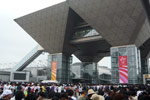Circles
As most anime fans are already aware, Comiket mostly sells doujinshis, usually fan made manga or books. The artists either self publishes their works themselves or gather together in what’s known as a circle. Many famous and popular manga, anime, and game artists attend Comiket often under a pen name or a circle name. For example, Rie Hiroe, author of the pirate/mercenary manga, Black Lagoon, uses the alias Tex-Mex. Many artists also start out at Comiket before becoming popular or discovered including Ken Akamatsu (creator of Love Hina and Negima! Magister Negi Magi) and CLAMP (creator of Card Captors, Tsubasa Chronicles, Kobato, and various other titles.) Often, many creators appear in person to greet their fans. We were able to meet with popular adult doujinshi author Inu and did a quick interview with him (coming soon.)
 The interesting aspect of Comiket is that it is completely operated by volunteers with the central theme that everyone is a participant including the staff, the general public, and the artist circles. With roughly half a million participants, the event can get pretty chaotic. In comparison to most anime conventions in the United States, Comiket is probably the most organized event in terms of line control and operations. Staff members are visible everywhere donning a yellow armband, a badge, and for some, a hat.
The interesting aspect of Comiket is that it is completely operated by volunteers with the central theme that everyone is a participant including the staff, the general public, and the artist circles. With roughly half a million participants, the event can get pretty chaotic. In comparison to most anime conventions in the United States, Comiket is probably the most organized event in terms of line control and operations. Staff members are visible everywhere donning a yellow armband, a badge, and for some, a hat.
Studios/Companies
 Apart from just the circles, many anime related companies such as studios, figure manufacturers, and game makers also make an appearance showcasing some of their latest works and selling exclusive event only products. These limited goods, often including figures, posters, wallscrolls, hug pillow covers, and telephone cards, typically end up on the second hand market selling for inflated prices. Since most these goods tend to sell out quickly, we highly recommend visiting them of the first day.
Apart from just the circles, many anime related companies such as studios, figure manufacturers, and game makers also make an appearance showcasing some of their latest works and selling exclusive event only products. These limited goods, often including figures, posters, wallscrolls, hug pillow covers, and telephone cards, typically end up on the second hand market selling for inflated prices. Since most these goods tend to sell out quickly, we highly recommend visiting them of the first day.
Accessibility to Foreigners? How to Make a Purchase?
For foreign attendees such as ourselves, Comiket does have an International Desk with staff members who speak various languages and can help answer any questions you may have. Some are even foreigners themselves. We met one staff member who spoke Japanese, English, and German. A little knowledge of Japanese would be helpful to foreigners but not a requirement since mostly people are there to make purchases. At the bare minimum, I would recommend learning how to count numbers in Japanese. Most prices for goods are all listed with signs. Simply just by pointing at what you want and saying how many copies you would like is enough. It was a rather awkward experience for most of us at first especially with a limited amount of Japanese. In the worst case, some of the vendors understand a little English. Be prepared to be starred at a lot especially if you don’t look remotely Asian.
The Catalogue
Before even setting foot on Japanese soil, we picked up the Comiket CD-ROM catalogue. There are over 35,000 circles that participate at Comiket, and trying to find a specific artist or circle can be pretty chaotic. Locals and veterans of the event typically purchase the telephone book sized Comic Market Catalogue released usually a few weeks in advance prior to the event which lists most of the vendors and circles including their location. The CD-ROM version also allows users to view and search circles by day, as well as the ability to add them to a user specified, color coded spreadsheet and map. Users can then print the labeled maps out. Some circles don’t release their participation information on their website until a few days before the event, so it’s best to utilize the catalogue.
Many of the more famous circles typically will have their doujinshi sold at retails such as Toaraona, K-Books, and Melon Books at increased prices; however, they will not include any of the limited goods such as telephone cards, printer bags, or copy book. It’s also best to realize that these items are usually the first to sell out. It is highly recommended that you do not attend Comiket alone if you are planning to get the limited items from the more popular circles. It’s best to go with friends and divide up the booths by halls. Most importantly, make sure you have a means of communication. For foreigners, rental cellphones are a possibility, or in our case, we purchased two way handheld radios (walkie talkies) before our trip. Interesting note, we observed a lot of the locals using their Nintendo DS to message each other.
Lines
 No matter where you are at Comiket, there will be lines, including the men’s bathroom. If you are hoping to obtain any of the limited goods, or make purchases from the popular booths, prepare to wait in some insanely long lines. Many of these lines will end up outside, so expect it to be hot and humid during the summer, and freezing cold during the winter. Bring some form of entertainment to keep yourself occupied. Most people we saw were playing with their Nintendo DS or reading a book. Some occasionally answered or made phone calls to friends who were also in line.
No matter where you are at Comiket, there will be lines, including the men’s bathroom. If you are hoping to obtain any of the limited goods, or make purchases from the popular booths, prepare to wait in some insanely long lines. Many of these lines will end up outside, so expect it to be hot and humid during the summer, and freezing cold during the winter. Bring some form of entertainment to keep yourself occupied. Most people we saw were playing with their Nintendo DS or reading a book. Some occasionally answered or made phone calls to friends who were also in line.
Comiket is definitely an event that every anime fan should experience at least once in their life. For the full experience, we recommend waking up early.

 With Comic Market 77 currently in full swing, we present to you our belated report from Comic Market 76. Comic Market (most commonly referred to as Comiket or Comike) is probably the largest fan comic event in the world attracting roughly half a million people, including ourselves. Join us on our journey to the one of the most difficult event coverage we have ever embarked on.
With Comic Market 77 currently in full swing, we present to you our belated report from Comic Market 76. Comic Market (most commonly referred to as Comiket or Comike) is probably the largest fan comic event in the world attracting roughly half a million people, including ourselves. Join us on our journey to the one of the most difficult event coverage we have ever embarked on.